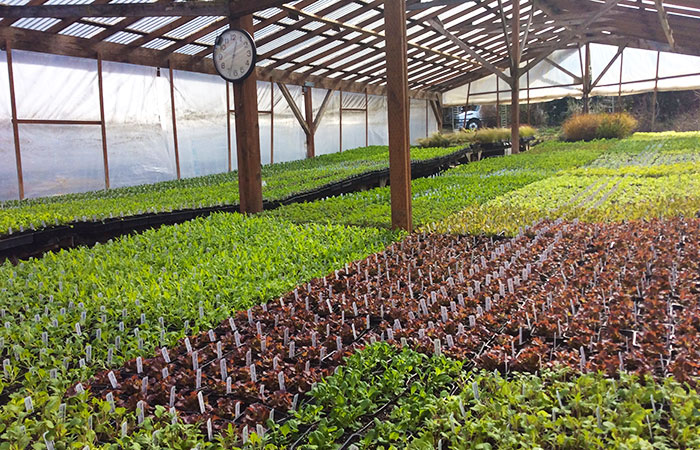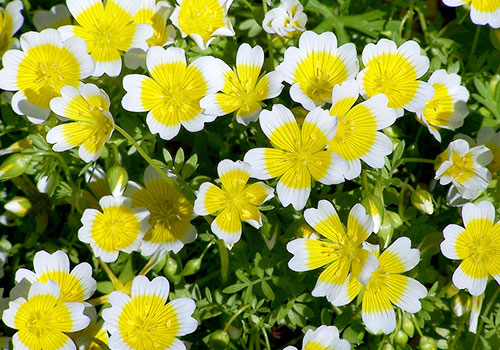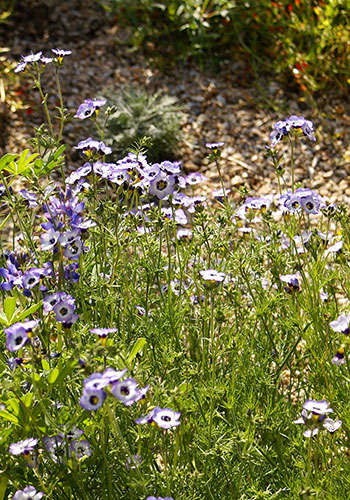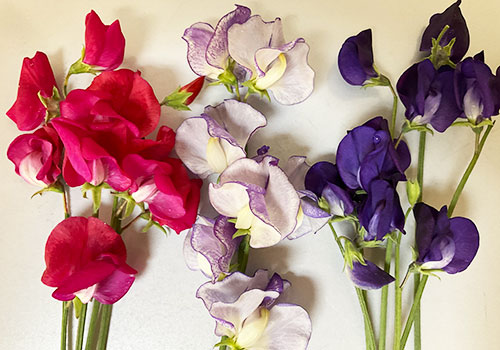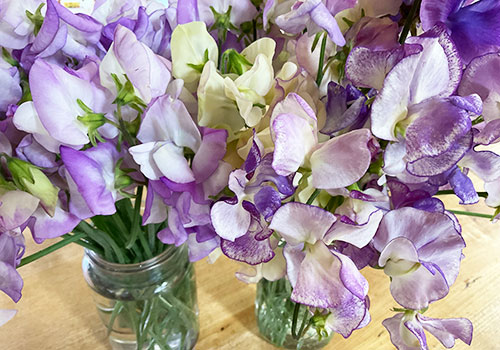Langley Fine Gardens Pt. 1 – Early Spring Favorites
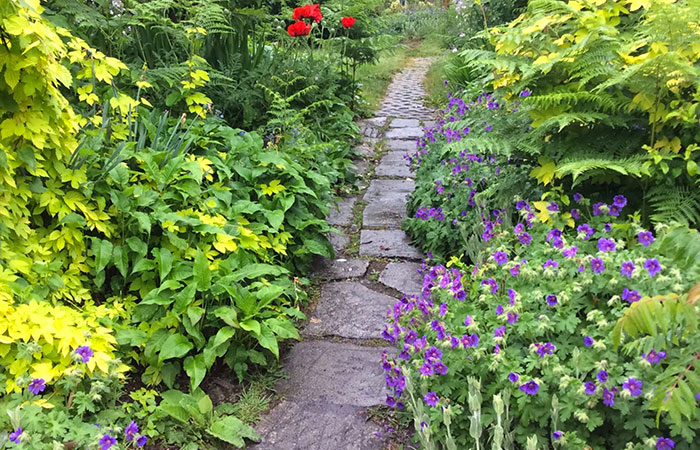
Sky Nursery has always been proud to partner with a rich community of local growers offering high-quality plants raised by and for our Pacific Northwest climate. You can check out some of our favorite sustainable and locally-grown seed companies in our blog post here. Today though, we get to share the exciting early spring arrivals and a little bit of backstory on one of our most beloved partnerships for specialty and heirloom annuals, vegetables, and select perennials: Langley Fine Gardens.
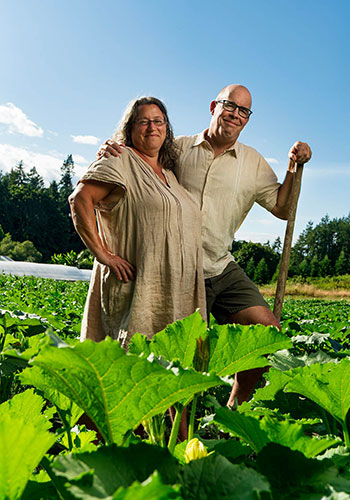
Langley is a small but mighty wholesale nursery that began in the Ballard backyard of Leda and Matt Langley in 1996. Later that year, the couple invested in a ‘fixer-upper’ property out on Vashon Island where they now steward a large pollinator garden, 6 greenhouses and a u-pick pumpkin patch that welcomes many Seattleites in the fall. Before the pandemic, Langley was a prominent vendor at many local farmers markets and nurseries, but now, Sky is one of just a few places where you can find their plants.
What really sets Langley apart is their special love for growing what we like to call ‘specialty annuals.’ These are the heirloom, old-fashioned, native, and harder-to-find plants that delight gardeners for their unique flowers, intense fragrance, pollinator attraction and more. Heirloom & open-pollinated annuals may only last for a season, but these plants are great to either save seed from or let reseed in your garden all on their own, providing you with years of blooms from a single plant (with good care). We just received our very first delivery for the spring season, so we thought we’d share a few of the special annuals we are looking forward to:
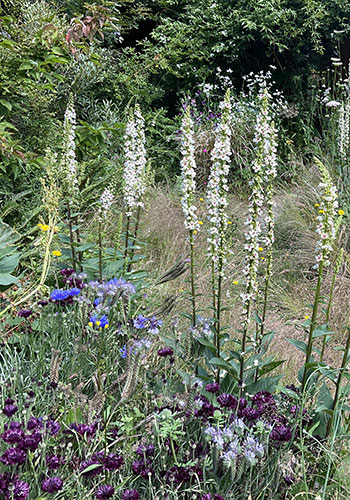
Bachelor Buttons
Centaurea cyanus -
Let’s start off with a garden classic: Centaurea cyanus, more commonly known as Bachelor Buttons or Cornflower. This is a great choice for novice and expert gardeners alike to plant in a full sun, well-draining spot; it even thrives in rocky or dry soils! Choose your favorite color from shades of blue and periwinkle in Langley’s ‘Classic Fantastic’ variety, or dazzling deep red ‘Black Garnet.’ (pictured at bottom of photo) If well-situated, this low-maintenance flower doesn’t need much to thrive. Fertilize lightly and deadhead to encourage new growth, and it can bloom all the way into August.
Bachelor buttons make excellent cut flowers and can be dried for wreaths (which Matt is well-known for) and displays. They are also edible, and great on salads! It’s a pollinator favorite since its nectar has a high sugar content, and is commonly planted en masse by beekeepers to help support hives. It also makes a great companion plant for veggies in the cabbage family, as it attracts predators for the troublesome Cabbage Moth (Mamestra brassicae). Although an annual, Bachelor Buttons will often self-seed and naturalize in following years.
Poached Egg Flower
Limnanthes douglasii
If you’d like to try something more unique, the poached egg plant, also called meadowfoam, has cheerful cupped, yolk-yellow blooms with bright white edges. This western US native can bloom all summer if sited in a good spot with full sun and moist soil. Limnanthes likes to spread and does well in borders, along paths or pools, and especially in clay-like soils. It will happily spread into lawns and other areas nearby, so keep that in mind when deciding where to plant as it can often self-seed the following year. Poached egg flowers are great for attracting butterflies, bees and other native pollinators, including bee-impersonating hoverflies that help to suppress aphid populations – a common problem in our Northwest gardens later in the summer.
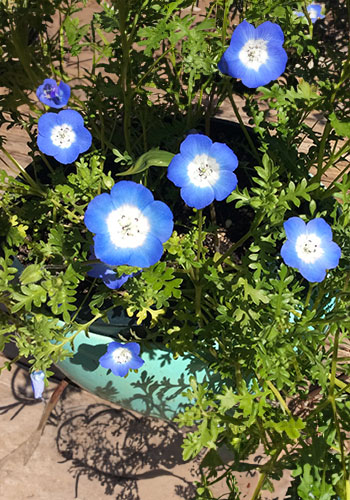
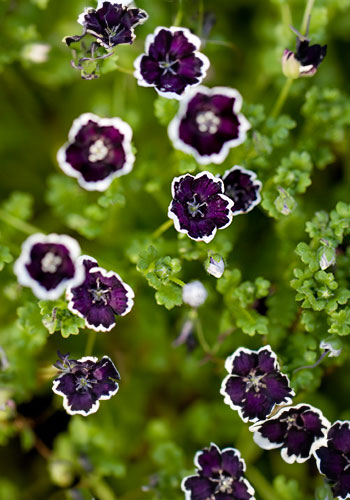
Baby Blue Eyes
Nemophilia menziesii
Like many specialty annuals, this one is also native to the western United States, and very attractive to pollinators. Its name means ‘woodland-loving’ in Greek, which gives you an idea of the type of environment it prefers – partial shade with moist but well-draining soil in a cool climate. ‘Baby Blue Eyes’ is the common name of the native variety from Langley: a pretty little cupped blue flower with a pale to white center. Other varieties include ‘Penny Black,’ a deep black-purple with white edges, and ‘Five Spot,’ a white flower with visible outward veining and purple-blue spots on each petal tip. Nemophila has a trailing or ‘drifting’ habit which makes it ideal for containers and hanging baskets or as a groundcover – tolerating light foot traffic. This plant might need a bit of protection if exposed to unusually hot summer temperatures, but it should self-seed for next year if planted in good conditions and with relatively good care.
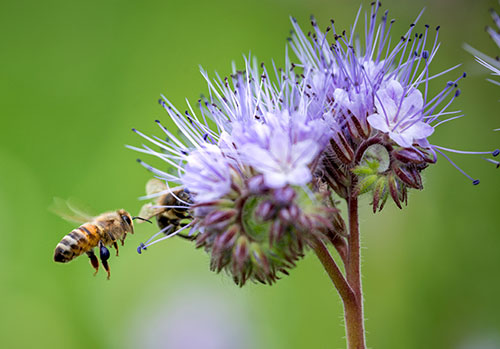
Bee's Friend
Phacelia tanacetifolia
If you consider yourself a friend to the bees (and other pollinators), consider growing P. tanacetifolia; its common name is literally ‘Bee’s Friend!’ The flowers are beautifully unique; small lavender blooms form in clusters along a curling ‘cyme,’ with long stamens that give them a soft feathery look. A western USA native more commonly found in California, Bee’s Friend prefers full sun, but will tolerate Washington shade and can grow to around 3 feet (!). It likes well-draining, sandy or rocky soil, has a fast growth rate, and is another annual with a good chance of self-seeding for the next year.
As you might have guessed, it's an excellent choice for attracting pollinators, and is frequently planted along vineyards to improve grape production. It attracts big fuzzy bumblebees, hoverflies, and butterflies, and is listed in the top 20 pollen producing flowers for honeybees! It is also an excellent long-lasting cut flower, though some people find that the fine ‘hairs’ along the stems and leaves can cause skin irritation.
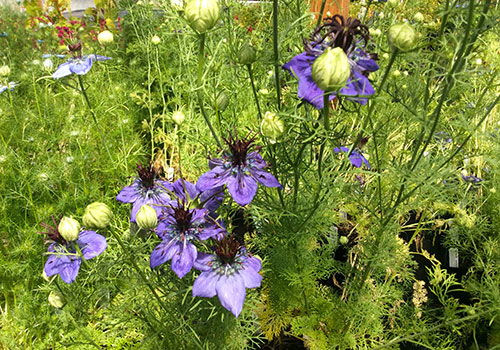
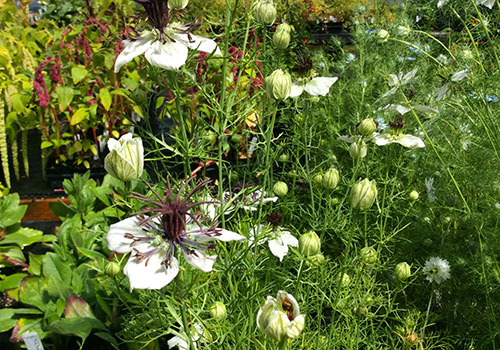
Love in the Mist
Nigella damscene
Nigella damascena is commonly known as ‘Love-in-a-Mist’ for the ferny little foliage bracts that surround the flower clusters, like a dewy mist. This plant is a sun lover and does well in a variety of soil conditions, though it prefers not to have ‘wet feet’ for too long. Flowers are commonly seen in shades of blue, but can also be white, purple, and pink. Love in a Mist does bloom for just a few weeks, so if you’d like to enjoy flowers into summer, we recommend planting in succession. Deadheading spent blooms can also prolong flower production, but will reduce the number of seeds available for growing next year, and many gardeners find the seedpods an attractive accent. Eventually, once Nigella is well-established, it can keep reseeding all by itself through the current season and into the next year.
Bird's Eye Gillia
Gillia tricolor
This CA native wildflower has spread as a popular ornamental all along the West Coast. It prefers full sun, thrives in a variety of soils including rocky and clay environments, and is drought tolerant (an ideal choice for PNW summer drought!). The small, five-petaled flowers typically come in shades of pale blue and purple and have a sweet scent sometimes described as ‘chocolatey.’ These flowers look best in mass plantings, or even mixed with other wildflower varieties like Lupine, Clarkia, and Penstemon. It boasts a long blooming season in good conditions and is rich in nectar, making them a favorite of bees, butterflies, and hummingbirds. Gilia is a reliable re-seeder and will spread, making it a great choice for cottage gardens, rock gardens, in containers, or along borders. It is also lovely in bouquets as a filler flower, serving a similar role to traditional Baby’s Breath.
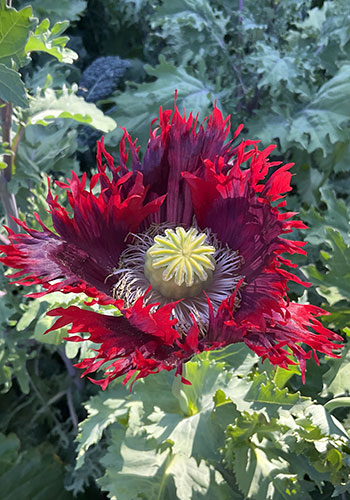
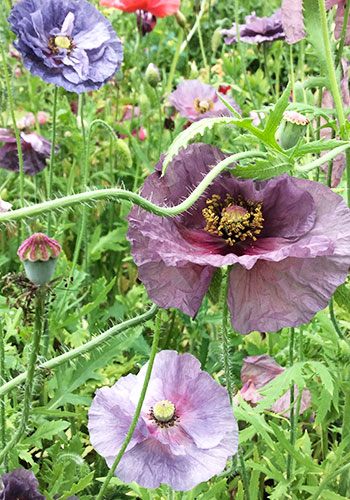
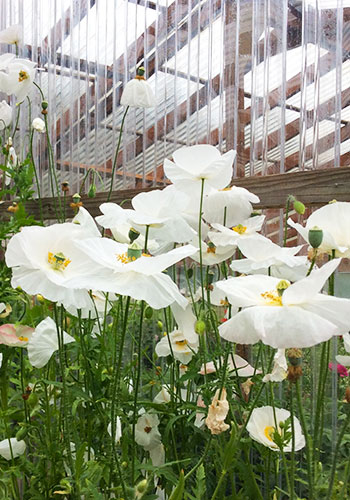
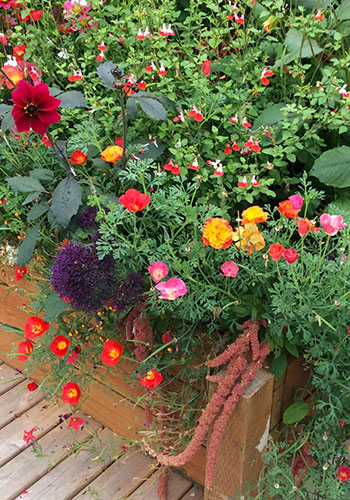
Poppies
Papaver
We are also expecting a ton of sought-after favorites in our first few Langley deliveries. Poppies, Papaver rhoeas and Papaver somniferum varieties such as the pristine white ‘Bridal Silk,’ the frilled edged ‘Drama Queen,’ the delicate ‘Falling in Love’ and the classic red ‘Ladybird’ are just a few you can choose from. California poppy (Eschscholzia californica) arrives in mid-March with varieties like ‘Copper Pot’ and “Jelly Beans’. These sun-loving flowers prefer rich, moist, well-draining soil and if left to develop seed pods, will happily reseed for next year.
Sweet Peas
Lathyrus odoratus
Sweet Peas are another cult-classic and we’ve ordered over 25 different varieties to come in our first few March deliveries! Our favorites include ‘Cupani’ with its vivid violet/maroon combination, ‘April in Paris,’ a pale ivory bloom with tinted edges of pink and violet, ‘Prince Edward of York’ with its classic rosy-red and fuschia, and ‘Painted Lady,’ a romantic pink and white flower that will bring a pop of bright color to any garden. If you have a sunny area with cool, moist soil conditions, these are the perfect choice for someone looking for an early-blooming and extremely fragrant flower. With good care, they can continue blooming into the summer which means you’ll have a regular parade of extremely fragrant, colorful bouquets in your home (how terrible!).
These flowers are really just the tip of the iceberg when it comes to all the plants we’re expecting from Langley Fine Gardens this spring. In the next month, look out for Calendula, Nicotiana, Snapdragons, Asters, Amaranth, Cuphea, Scabiosa, Marigold, Salpiglossis and Cosmos, with hot season favorites like coleus and sunflowers arriving in May! Additionally, a whole selection of heirloom and open-pollinated tomatoes, including Langley's own uniquely fuzzy variety, ‘Langley Silver Tiger’ is expected to start arriving in mid-April. Keep your eyes open for more posts highlighting more Specialty Annuals in April and May, and in the meantime, happy spring and gardening!
All Photo Credit is to Langley Fine Gardens, unless otherwise specified.
